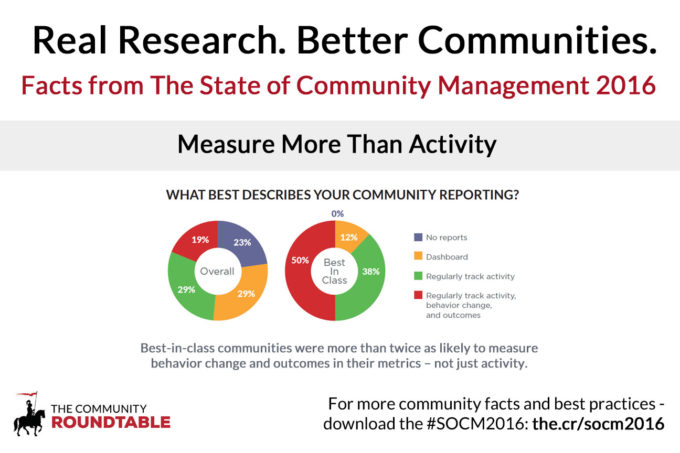By Ted McEnroe, Director of Research and Training
What is the best way to capture the value of your community?
Communities serve a number of strategic uses, so it can be hard to come up with the metrics that best demonstrate how the community delivers on that strategy. But one thing is certain – the basic activity metrics – logins, visits, and such – won’t capture that value. While almost every community tracks basic activity, best-in-class communities are far more likely to measure behaviors and outcomes than the average community.
Why? It’s no accident. People, groups and organizations typically focus on things that they know are being measured, from the kid who asks, “Will this be on the test?” to the executive who pays closest attention to the numbers that go in the report to his CEO. When you select metrics that get at the behaviors you want in the community, you focus on those behaviors. It’s human nature.
So what should you do? Here are 5 tips.
1. Start with what you want to see, not with what you have.
One bit of bad news if you hoped this was easy. The easy stuff that your community platform delivers you in pretty charts probably doesn’t get it done. Visits, posts and logins make for easy graphics, but they don’t necessarily tell you if people are getting value.
Behavioral metrics also take longer to move. Activity can ramp up quickly – and there is nothing wrong with looking at activity metrics to make sure people are coming to the community and doing things, especially when you are just getting started. But as your community matures, it’s less about them showing up and more about the ways they are giving and getting value.
“Visits, posts and logins make for easy graphics, but they don’t necessarily tell you if people are getting value.”
2. Push the value conversation.
It’s really hard to measure fog. If you can’t express the value of the community to the organization and its members in a clear, concise way, you’ll have a hard time getting members to engage (because they don’t know why they should). But equally important, you won’t know when you are truly delivering value. Stories and anecdotes get you there for a while, especially at the start. But at some point, you’ll need hard numbers – so nail the value piece down.
3. Make metrics a part of the strategic conversation from day one.
Once you have your value defined, identify and begin tracking the metrics. It’s OK if your numbers aren’t huge right off the bat. Your metrics are the way you will be able to track your progress, and will help you troubleshoot, generate new ideas and recognize gaps.
Plus, you don’t want to be caught flatfooted when someone above wants to know whether this community investment is paying off.

4. Share your data with an eye toward your audience.
When preparing your data – remember who it’s going to. Your immediate boss may want the intimate details of which customer forums are generating the fastest community response times to support questions. Your CEO probably doesn’t.
5. Storytelling still matters.
While getting the right metrics is critically important, qualitative data, case studies and clear examples bring a human face to the numbers on a page. Don’t get so caught up in the numbers that you stop gathering the pieces that you can attach to show the human business impact of a 58% increase in number of questions answered in your platform.
We can’t wait to hear what you think – tag your thoughts with #SOCM2016 to join the conversation!
Are you a member of TheCR Network? Download the research inside the Network here.
